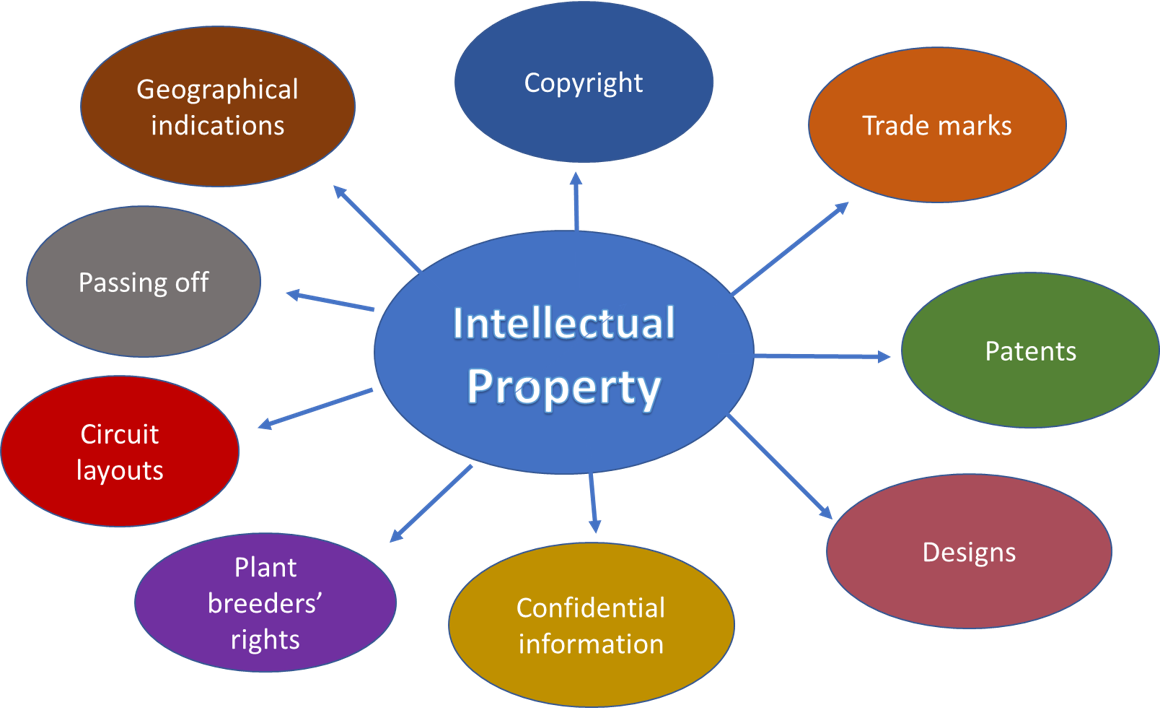PERSPECTIVE| ‘INTELLECTUAL PROPERTY RIGHTS’

Context:
- 26th April is World Intellectual Property Day.
Details:
- Intellectual property is the most valuable asset in the modern age, rewarding as it does the technological innovation that drives human progress.
- It also helps the global arts scene to flourish.
- In 1970 the World Intellectual Property Organization was set up. It was aimed at increasing general awareness and understanding of IP.
- Essentially Intellectual property refers to the creations of the mind.
- That includes inventions of all kinds, literary and scientific, artistic works, designs and a lot of other things.
- They can also refer to individuals whose reputation itself commands commercial advantage and profit.
| The World Intellectual Property Organization sets down the rules to confer certain exclusive rights to the inventors or creators of that property so that they can reap commercial benefits from their creative efforts or reputation. |
About Intellectual Property Rights
Meaning:
- Intellectual property (IP) is a category of property that includes intangible creations of the human intellect.
- Intellectual property rights include patents, copyright, industrial design rights, trademarks, plant variety rights, trade dress, and geographical indications.

Objective:
- The main purpose of intellectual property law is to encourage the creation of a wide variety of intellectual goods, to achieve this, the law gives people and businesses property rights to the information and intellectual goods they create, usually for a limited period of time.
- This gives economic incentive for their creation because it allows people to benefit from the information and intellectual goods they create and allows them to protect their ideas and prevent copying.
- These economic incentives are expected to promote innovation and contribute to the technological progress of countries.
READ: https://www.iasgyan.in/daily-current-affairs/intellectual-property-rights-ipr
Types of Intellectual Property Rights(IPR)

Copyright:
- Copyright refers to the right to “not copy”. It is a right pertaining to Intellectual property such as literature, art, music, sound recording, and cinematography.
- Copyright prohibits the unauthorised use of the content, including acts such as the reproduction and distribution of copies of the subject matter.
- Copyright enables the protection of work automatically as soon as the work comes into existence.
- The registration of the copyright, though not mandatory, is essential to exercise the right in case of an infringement.
Trademark:
- A trademark is any word, name, and symbol, or a combination of words, names, and symbols that lets us identify the goods made by an individual, company, or organisation and also differentiates such goods from those of other parties.
- Examples of trademarks include the Apple logo, LG logo, Dell logo, Audi logo, etc.
- There are many kinds of trademarks available to a goods/service provider in India such as Product marks, Service marks, Collective marks, Certification marks, Shape marks, Pattern marks, and Sound marks.
- The registration of a trademark, though not mandatory, is essential to establish exclusive rights over such marks.
Geographical Indication:
- A geographical indication is used to identify and distinguish agricultural, natural, or manufactured products from one geographical location to another.
- Manufactured products further entail handicrafts, industrial goods, foodstuffs, etc. Such indications play a very important role in highlighting the various components of our heritage, and collective goodwill of a certain geographical region, that has been created over a period of time.
- For example, many food items such as fruits and other things like wool, yarn, etc., come with labels on their packages that specify the state or region they have been cultivated in or manufactured in so as to reap the benefits of their goodwill, like Darjeeling is famous for its tea, Nagpur is famous for its oranges, Kashmir for its Pashmina wool, etc.
Patent:
- It is a right conferred upon the inventors of a certain device or entity.
- Patents are conferred only upon inventions and not the discovery of a phenomenon. Invention here refers to coming up with a device or an idea with your own mind, whereas discovery means simply getting to know and find out something that already exists in the universe.
- The distinction between discovery and invention can be understood with the following example: Isaac Newton discovered gravity when he saw an apple falling from a tree while Alexander Graham Bell invented the telephone. In this case, the telephone can be patented for being an innovation, but not the gravitational laws.
Design:
- Nowadays customers face an enormous choice of products, including many that offer the same basic functionality. So they will tend to choose the one with the design they find the most attractive within their price range.
- Industrial products and handmade goods are the primary entities that use design laws.
- These include cars, telephones, kitchen utensils, electrical appliances, etc.
- Such rights entitle the right holder to control the commercial production, import, and sale of products with the protected design.
Plant Variety:
- Animal and plant breeders also enjoy special rights over the species/varieties of flora and fauna bred by them.
- Some parties argue that such varieties are a result of a natural phenomenon; however, they are usually the representatives of gene combinations and skillful natural selection.
- A number of laws govern the rights available to plant varieties and their breeders, the primary ones being- The Plant Variety Protection Act, 1970, and The Utility Patent Act, 1985.
Semiconductor Integrated Circuits Layout Design:
- Semiconductors are an important part of a computer chip, designed to perform an electronic circuitry function.
- The term Semiconductor Layout Design refers to the design or layout of transistors and other elements involved in circuit work in computers.
- Special rights are conferred for the protection of semiconductor integrated circuits layout- designs so that rival companies do not copy the design and sell it as their own

IMPORTANCE OF IPR
Boost Business Growth:
- There are chances of business ideas/strategies being stolen by rival businesses in order to capture the firm’s market share and decelerate business growth.
- Therefore, small and medium enterprises need to protect their exclusive goods and services because losing out on market share and potential customers can be very harmful to such firms in the beginning stages.
- Thus, IPRs help such firms by preserving their ideas.
Easing the Marketing Process:
- Intellectual property is an essential tool for creating an identity for a business.
- It helps a firm in distinguishing its own products and services in the market from those of others; thus, encouraging easier reach to the target customers, thereby making the whole marketing process very seamless.
Safeguarding Unique Ideas:
- Many a time people try to copy the creation of others for their own commercial profit.
- It becomes essential to protect such ideas and creations from rival parties to ensure exclusivity and uniqueness in one’s own creation.
Raising Funds:
- Any Intellectual Property Right owner is free to monetise and commercialise his Intellectual Property assets through sale, licensing and use as a guarantee for debt financing.
- Intellectual Property Rights can also be used to raise funds through public borrowings, loans, and government subsidies.
Enhancing Export Opportunities:
- A business with registered IPRs can use its brands and designs to market its goods and services in other markets too.
- It means that a business with registered IPRs can tap into franchising agreements with foreign companies or export their patented products.
Types of Intellectual Property Rights in India
The Copyrights Act, 1957 (“Copyright Act”)
- Copyright protects the expression of an idea rather than the idea itself.
- Under section 13 of the Copyright Act, a protection under copyright can be obtained for ‘original literary, dramatic, musical and artistic works; cinematograph films; and sound recording’.
- Interestingly, a copyright protection can also be obtained for computer programmes.
The Trade Marks Act, 1999 (“Trade marks Act”)
- The Trade Marks Act, under section 2(zb) defines a ‘trade mark’ as ‘a mark capable of being represented graphically and which is capable of distinguishing the goods or services of one person from those of others and may include shape of goods, their packaging and combination of colours…’.
- In simpler words, a trademark provides protection for symbols, colours, shapes, words, etc. representing and relating to a good or a service.
The Patents Act, 1970 (“Patents Act”)
- A ‘Patent’ is an intellectual property right which protects any new invention. It is an exclusive right that protects the rights of the inventor and prevents other people to unauthorizedly use and misappropriate the registered patent.
The Design Act, 2000 (“Design Act”)
- A ‘design’ under the Designs Act [section 2(d)] means and includes ‘only the features of shape, configuration, pattern, ornaments or composition of lines or colours, applied to any article whether in two dimensional or three dimensional or in both forms, by any industrial process or means, whether manual, mechanical or chemical, separate or combined, which in the finished article appeal to an are judged solely by the eye’.
The Geographical Indications of Goods (Registration and Protection) Act, 1999 (“GI Act”)
- Many goods in India are widely popular owing to their place of origin. For instance, ‘Darjeeling tea’ is unique and popular owing to many factors including but not limited to its origin, the skill set of the tea farmers of Darjeeling and the weather prevailing in that area.
- Other such examples of products which have a bearing of the place of origin (or factors specific to the place of origin includes Banarsi Saree; Basmati Rice, etc).
The Protection of Plant Varieties and Farmer’s Rights Act, 2001 (“Plant Varieties Act”)
- The objective of the Protection of Plant Varieties and Farmer’s Right Act, 2007, is to recognize rights of Indian farmers and to provide protection to plant varieties in order to encourage the growth and development of more plant varieties.
The Semiconductor Integrated Circuits Layout- Design Act, 2000 (“SICLD Act”)
- A ‘semiconductor integrated circuit’ is defined as ‘a product having transistors and other circuitry elements which are inseparably formed on a semiconductor material or an insulating material or inside the semiconductor material and designed to perform an electronic circuitry function’.
ISSUES OF IPR
Patent Evergreening Prevention:
- One of the most important intellectual property rights issues challenges is the prevention of the evergreening of the patents for multinational companies.
- As we know, the companies cannot evergreen their patents simply by making minor changes.
Subsidies & IPR Issues:
- The government provides subsidies to people especially farmers to reduce their burden. A major form of subsidies includes food subsidy, fertilizer subsidy, education subsidy, etc.
- However, for the complete implementation of TRIPS agreements, one needs to reduce or eliminate these subsidies.
- Thus, the Indian government needs to create a balance between providing subsidies and providing IP rights in India.
The Product Patents Process:
- A product patent protects a product. It offers high protection to the original inventor to reduce the competition for the same product.
- Whereas, a process patent protects the process through which one manufactures the product and not the product. It reduces the element of monopoly in the market.
- As India is a part of the TRIPS agreement, the agreement requires all its members to shift their patent regime from process to product patent.
Protecting traditional knowledge:
- Traditional knowledge, especially in the field of medicine, is like a gold mine.
- The Indian government is bound to protect the traditional knowledge by not allowing MNC’s to get patents on the traditional culture.
Compulsory Licensing & Drug Price Control Order:
- One of the most important intellectual property rights issues that the government needs to address is the use of compulsory
- It’s a relaxation available to the developing countries under the TRIPS agreement, something which organizations misuse sometimes
GOVERNMENT INITIATIVES RELATED TO IPR IN INDIA
- The Cell for IPR Promotion and Management (CIPAM) has been set up to coordinate the implementation of the National IPR Policy.
- IP awareness programmes have been undertaken in academic institutions, at both school and college levels, as also for industry.
- To streamline the processing of IP applications, IP procedures have been simplified and made user friendly by amendment to the Patents Rules in 2016 and Trademarks Rules in 2017.
- Under the amended Patents Rules, 80% patent fee reduction has been provided for Startups as compared to large companies.
- Establishment of Center of Excellence in Intellectual Property.
- Providing IP Facilitation Support, Help-Desk services for IPR.
- Creation of IPR Awareness through Digital Media.

WAY FORWARD:
- There is an immediate need to take corrective steps to achieve the full potential of geographical indications.”
- Provisions for stronger enforcement and action against Violation are the need of the hour”.
- Awareness campaigns, especially in rural areas, on these intellectual property rights and promotes the success stories of Darjeeling Tea, Chanderi Silk, etc.
- Building sufficient capacities in the high court’s so that intellectual property litigation can be conducted efficiently and smoothly.
- These new and additional challenges can be effectively met by strengthening the high courts.
- Need to fill the existing vacancies on an urgent basis, but there is also a need to increase the number of judges.
- Judicial infrastructure needs to be improved. Mere allocation of funds is not enough. The challenge is to put the available resources to optimum use.
- While adjudicating the claims of intellectual property rights, a balance must be struck between contemporary claims and the sustainable interests of future generations.
Conclusion
- In India, there are different forms of intellectual property rights, allowing a person to obtain protection for their assets.
- India has actively become party to many conventions and treaties in order to afford international recognition and protection for intellectual property rights recognized in India.
- Some conventions have led India to introduce new enactments such as the Plant Variety Act, in order to award protection to goods that represent the heritage, agricultural background and fauna of India.
https://sansadtv.nic.in/episode/perspective-intellectual-property-rights-26-april-2023






